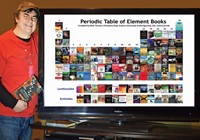Advertisement
Grab your lab coat. Let's get started
Welcome!
Welcome!
Create an account below to get 6 C&EN articles per month, receive newsletters and more - all free.
It seems this is your first time logging in online. Please enter the following information to continue.
As an ACS member you automatically get access to this site. All we need is few more details to create your reading experience.
Not you? Sign in with a different account.
Not you? Sign in with a different account.
ERROR 1
ERROR 1
ERROR 2
ERROR 2
ERROR 2
ERROR 2
ERROR 2
Password and Confirm password must match.
If you have an ACS member number, please enter it here so we can link this account to your membership. (optional)
ERROR 2
ACS values your privacy. By submitting your information, you are gaining access to C&EN and subscribing to our weekly newsletter. We use the information you provide to make your reading experience better, and we will never sell your data to third party members.
Education
Café Au Chemistry, Virtual Sherlock Holmes
by Susan J. Ainsworth
June 27, 2011
| A version of this story appeared in
Volume 89, Issue 26
In Switzerland, where better to promote the International Year of Chemistry (IYC) than in a café? That’s undoubtedly what Barbara Winter-Werner, chief science officer of the Platform Chemistry unit at the Swiss Academy of Sciences, thought.
Working with Fribourg, Switzerland-based dairy company Cremo, she created chemistry-related motifs for the individual-portion TUBS OF CREAMER that are served with coffee in most cafés and restaurants in Europe. The images that decorate the foil tops are usually changed frequently, “inviting the customer to learn something new or reflect a little,” according to the Cremo website.
In the chemistry series, the little foil disks depict chemical compounds from food, plant, and other products that people might encounter in daily life. Not surprisingly, some coffee-related compounds such as caffeine, lactose, sucrose, and vanillin make the list. Other featured compounds include water; ascorbic acid; α-bisabolol, the main ingredient in the essential oil of chamomile; linalyl acetate, the main component of lavender oil; and coumarin, which gives fresh hay its unique, spicy odor.
The creamers bearing the chemistry foil caps were produced between March and May of this year and can be found in coffee shops and restaurants until sometime in July—or until they have reached their expiration dates. Thanks to readers Helmut Brandl, an environmental microbiologist at the University of Zurich, and International Labor Office retiree Emmert Clevenstine of the French suburbs of Geneva for bringing these dairy delights to the Newscripts gang’s attention.
Winter-Werner’s project is just one of many IYC-related projects under way at the Swiss Academy of Sciences. This year, the organization joined forces with the Swiss Chemical Society and SGCI Chemie Pharma Schweiz, an association of chemistry, pharma, and biotech companies across Switzerland, to plan special events for IYC in the mountainous country known for its milk and chocolate.
One event that “coincides neatly with the celebration of IYC” is the launch of the ’s first virtual issue in March, according to Erica K. Jacobsen, JCE associate editor. The issue features a series of intriguing and fun stories—”The Chemical Adventures of SHERLOCK HOLMES”— that will surely be “elementary” to many of our dear Newscripts readers.
Through the virtual issue format, the journal was able to bring together stories published in JCE between 1989 and 2004 by Thomas G. Waddell and Thomas R. Rybolt of the University of Tennessee, Chattanooga, and in 2008 and 2009 by Ken Shaw, a secondary school teacher at the Waterford School in Sandy, Utah. Borrowing from Sir Arthur Conan Doyle’s works that date back to the late 1800s, the stories revolve around the characters Sherlock Holmes and Dr. Watson “but with a twist—the authors bring chemistry into every mystery,” Jacobsen says.
The stories illustrate a wide range of chemistry, including laboratory and scientific practices in “Sherlock Holmes and the Fraudulent Ketone,” stoichiometry calculations in “The Case of the Stoichiometric Solution,” and qualitative analysis, descriptive chemistry, and forensics in “The Serpentine Remains.”
As testament to the timeless appeal of Sherlock Holmes, Jacobsen’s commentary that describes the virtual issue and that provides a link to the collection (J. Chem. Educ., DOI: 10.1021/ed200021z) has already attained a spot in the top 20 most read articles list for JCE for the past 12 months, despite being available to readers since only March.
Now, during IYC, Jacobsen says, “the stories, with their connections to literature, compelling mysteries, and chemistry, provide an excellent avenue for communicating chemistry to others.”




Join the conversation
Contact the reporter
Submit a Letter to the Editor for publication
Engage with us on Twitter